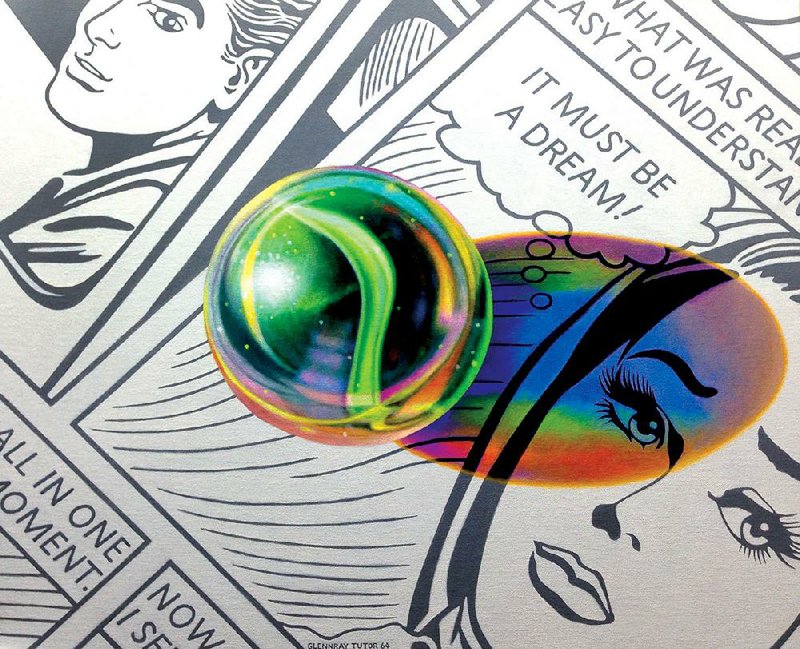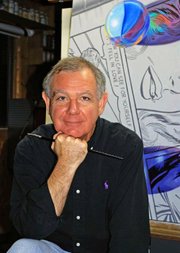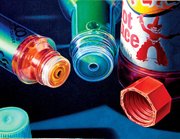Pick a painting. Any painting.
Glennray Tutor, a leading photorealist in American art, believes that painting should be "a magic trick that's real magic." When a viewer examines his work, "I want the viewer not to be distracted by the technique."
Glennray Tutor
Through Aug. 13, Greg Thompson Fine Art, 429 Main St., North Little Rock
Hours: 10 a.m.-5 p.m. Tuesday-Friday, 11 a.m.-4 p.m. Saturday
Info: (501) 664-2787
Tutor's magic is on display at Greg Thompson Fine Art in North Little Rock through Aug. 13, his first solo show in eight years. The exhibition features a colorful set of oil paintings dating from 1990 to 2016. The work explores various themes, including an assortment of images of comic books, marbles, fireworks, and hot sauce bottles, rendered with clinical precision.
It is easy to look at Tutor's work and imagine that the 65-year-old Oxford, Miss., resident creates his paintings employing a projector and/or a grid to precisely copy a photograph onto the canvas, and then paints it using an airbrush.
This is not the case.
"I'll actually set a still life up, then I take photographs of it," Tutor says. "Now, if you look at the photograph and compare the photographs I use as reference for the final painting, you would probably think that it doesn't even look like the same thing ... it changes so much as I work on it."
"It's not a happy thing," Tutor emphasizes. "It's sometimes extremely frustrating because I think what I am seeing with the composition, that it's going to be the same thing that I end up with in the painting, but no. It rarely goes that way."
Much of the work in the show concerns three major subjects: fireworks, hot sauce and comic book pages that have marbles lying on top of them (photorealistic painters seem to love to paint marbles: Charles Bell and Doug Bloodworth are two others who've featured marbles prominently in their work).
MARBLES AND COMICS
There are nine paintings in the marbles-and-comics series. In these, Tutor contrasts intensely colorful, 3-D marbles and their shadows with flat, black-and-white comic book panels. In Solo (It Must Be a Dream) from 2015, a single, multi-colored marble sits on a comic book, with the marble's colorful shadow falling across a woman's face. Tutor has painted an idealized beauty with a wistful look on her face, as she thinks, "This must be a dream."
All the comic book artwork reflects his take on a 1950s romance comic, with figures and faces resembling a highly refined version of comic book artist Murphy Anderson's style.
Other paintings in this series include one, two or three marbles placed on similar comic book pages. They are all essentially variations on a theme. It's easy to understand the popularity of these pictures. They remind us of the '50s and '60s, an era when kids read comic books and played with marbles for fun. In an increasingly digital age, these paintings reflect a simpler time.
FIREWORKS PAINTINGS
There are six fireworks paintings in the show, with perhaps the most impressive of these being 1993's Sprite. It is a large canvas (60-by-60 inches) filled with fireworks and fireworks boxes. The colors on all the fireworks paintings are especially intense, and the image is highly embellished.
In the moody Sunrise (2016), a couple of soft drink bottles with fireworks in them are set against a floral-pattern background, with dark shadows lending a somewhat ominous feeling to the scene. In Triad, three airplane-style fireworks are on display. The triptych Whistling Moon arranges the tops of three bottles, each with its own firework, against a backdrop of boxes of fireworks. All of these paintings are very detailed and carefully composed.
HOT SAUCE AND MORE
Caps Off! is an exquisitely painted 2002 canvas with two bottles of hot sauce turned on their sides, angled toward the viewer, with a portion of another bottle standing on the right side and a couple of bottle caps placed strategically in the composition. It's a smaller canvas, and the simple composition and more muted colors make this one of the most satisfying images in the show. Seven Sauces is a pretty straightforward composition that includes, not surprisingly, seven different bottles of hot sauce in a simple, straight-ahead arrangement.
One painting in the show is a bit different, which makes it stand out. Premium Regular is a work on paper from Tutor's poster series, another nostalgia-tinged set of paintings.
"Nostalgia is very important to me," Tutor says. There are only a few paintings in this particular series, and Tutor has never shown them before. There are old Gulf and Crown gasoline logos. There is type in all caps, some referring to fireworks, saying things like 'ADULT SUPERVISION' and 'KWANGTUNG, CHINA' and the title, 'PREMIUM REGULAR,' which is written across the top. The dominant image is of a woman riding a rooster that is derived from a 1930s snuff box. The work is lighter in tone than the others and is painted in a slightly looser style. As an image, it may relate more to pop art than to photorealism.
Overall, these paintings display an incredible consistency in terms of quality. These are images produced by a highly skilled artist, a craftsman at the top of his game. Since all the images are so well made, there's a certain cosmetic sameness about them. Because of this, the subject matter and the ideas behind them carry a lot of weight in differentiating the images and assessing their individual value as art.
When asked about their meaning, Tutor has this to say about the marble/comic book images in particular:
"First of all, do not look at one of my paintings and take it at face value. A marble is a marble. But if you stop there, you're missing 90 percent of the iceberg. You've got to get into the metaphor, symbolism, the way one thing affects something else, or contrasts to it or is similar to it. All this other stuff is going on."
Tutor speaks about metaphor and about dualities; he mentions quantum and cosmic infinities and other ideas that perhaps only he can fully grasp. In the end, though, the paintings speak for themselves, and they tell us a story about time and space, and most of all, nostalgia.
A lot of Tutor's appeal is based on his uncanny skill in rendering these images. Much of the rest is based on a longing for things past.
Style on 07/31/2016


